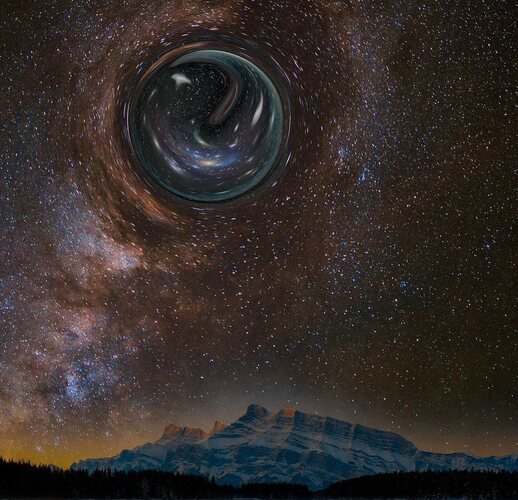A recent study has proposed the first-ever practical blueprint for a lab-created wormhole that can verifiably bridge spacetime.
Using quantum computing and the principles of quantum entanglement, the new experimental protocol could ultimately allow for the disembodied transport of unknown qubits without a sender or receiver ever having to exchange particles.
The process sounds like teleportation or the hypothetical transfer of matter or energy from one point to another without traversing physical space. However, unlike teleportation, researchers say their process does not require pre-shared entanglement or classical communication between a sender and receiver.
Study author Dr. Hatim Salih, an honorary research fellow at the University of Bristol’s Quantum Engineering Technology (QET) Labs and co-founder of the start-up DotQuantum, has termed this new process “counterportation.”
“This is a milestone we have been working towards for a bunch of years,” said Dr. Salih. “It provides a theoretical as well as practical framework for exploring afresh enduring puzzles about the universe, such as the true nature of spacetime.”
Physicists have long proposed that wormholes, or structures connecting disparate points in spacetime, could exist. Unlike the concept of faster-than-light travel, wormholes are based on a special solution of the Einstein field equations, and their existence is consistent with the general theory of relativity.
Some prominent theoretical physicists, such as the late Dr. Stephen Hawking and Dr. Kip Thorne, have even argued that it might be possible to artificially create and stabilize a traversable wormhole that could connect points that are billions of light years apart or even afford the ability for time travel.
However, to date, the actual physical occurrence of a wormhole has never been observed or verified.
Be that as it may, the emerging field of quantum computing has allowed scientists to begin flirting with ideas that, up to this point, have been entirely regulated to science fiction.
In November, scientists at Cal-Tech University developed the first-ever quantum experiment to study the behavior of a theoretical wormhole.
Two years ago, scientists at Fermilab announced the first-ever successful demonstration of sustained long-range, high-fidelity quantum teleportation. The ground-breaking achievement represented a significant step towards realizing a viable quantum internet, which researchers say will revolutionize the world of computing and information technology.
“Once fully developed, [quantum computers] can solve important problems that would take a classical computer millions of years,” Dr. Daniel Oblak of the University of Calgary told The Debrief. “A quantum internet, on which quantum computers or sensors are connected and share quantum information, may well surprise us with applications we have not yet imagined.”
“Quantum teleportation” plays a crucial role in quantum information technologies. However, the process does not involve the transference of physical objects from one location to another like popular fictional depictions of teleportation, such as the transporter used by members of the U.S.S. Enterprise in the television series Star Trek.
“Quantum teleportation has a somewhat unfortunate association with sci-fi renditions of teleportation,” explained Dr. Oblak. “In quantum teleportation, the quantum state of a particle is transferred to another pre-existing particle at another location. Hence, teleportation in the sense of being beamed up by Scotty will require the complete set of basic constituents, i.e., all the atoms, to be present at the receiving end for the quantum information to be encoded onto it.”
Yet, unlike quantum teleportation, Dr. Salih’s proposed concept of “counterportation” could allow for the interaction-free transfer of information or shortcuts in the fabric of spacetime that would resemble the colloquial idea of teleportation.
“While counterportation achieves the end goal of teleportation, namely disembodied transport, it remarkably does so without any detectable information carriers traveling across,” said Dr. Salih.
The proposed method is claimed to be “multiple orders of magnitude more efficient in terms of physical resources than previously proposed implementation, paving the way for a demonstration using existing imperfect devices.”
Dr. Salih says he is working with leading quantum experts to test his theory, including building a verifiable and observable wormhole in a laboratory setting. “The goal in the near future is to physically build such a wormhole in the lab, which can then be used as a testbed for rival physical theories, even ones of quantum gravity,” added Dr. Salih.
“This work will be in the spirit of the multi-billion ventures that exist to witness new physical phenomena, like the Laser Interferometer Gravitational-Wave Observatory (LIGO) and the European Organization for Nuclear Research (CERN), but at a fraction of the resources. Our hope is to ultimately provide remote access to local wormholes for physicists, physics hobbyists, and enthusiasts to explore fundamental questions about the universe, including the existence of higher dimensions.”
As promising as this sounds, the idea of using a traversable wormhole to “counterport” across the cosmos like Capt. Kirk is, unfortunately, not something we’ll likely see anytime soon. Namely, because the process will require developing an entirely new type of quantum computer.
“If counterportation is to be realized, an entirely new type of quantum computer has to be built: an exchange-free one, where communicating parties exchange no particles,” said Dr. Hatim.
“By contrast to large-scale quantum computers that promise remarkable speed-ups, which no one yet knows how to build, the promise of exchange-free quantum computers of even the smallest scale is to make seemingly impossible tasks—such as counterportation—possible, by incorporating space in a fundamental way alongside time.”
Nevertheless, suppose researchers are eventually successful in realizing a lab-created wormhole and demonstrating the concept of counterportation. In that case, scientists say that among the obvious benefits, this would also provide a “smoking gun” for the existence of a physical reality within the universe’s inner workings.
“From Counterportation to Local Wormholes” was recently published in the journal Quantum Science and Technology.
Tim McMillan is a retired law enforcement executive, investigative reporter and co-founder of The Debrief. His writing typically focuses on defense, national security, the Intelligence Community and topics related to psychology. You can follow Tim on Twitter: @LtTimMcMillan. Tim can be reached by email: tim@thedebrief.org or through encrypted email: LtTimMcMillan@protonmail.com

